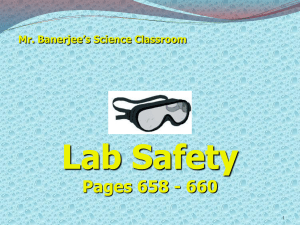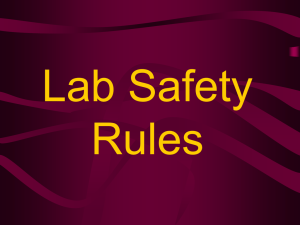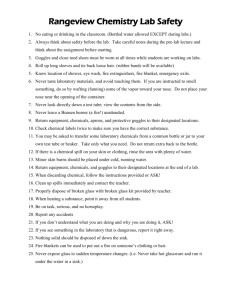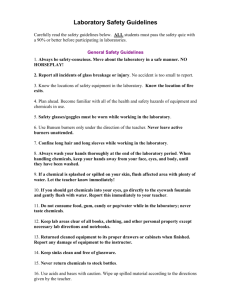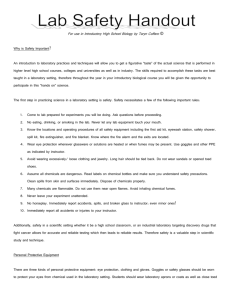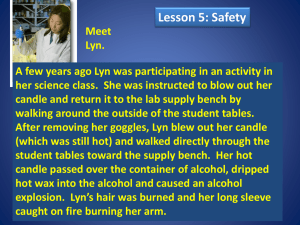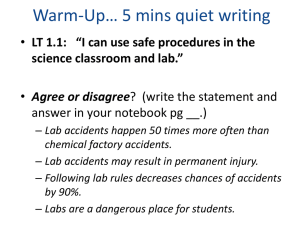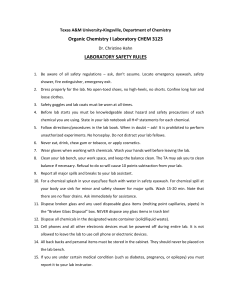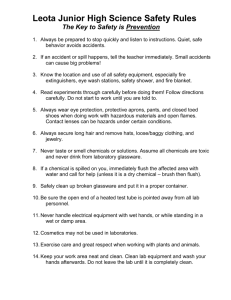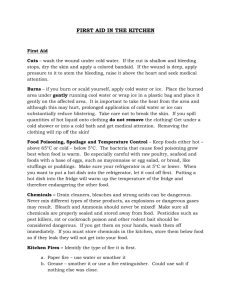Safety in the Science Laboratory
advertisement
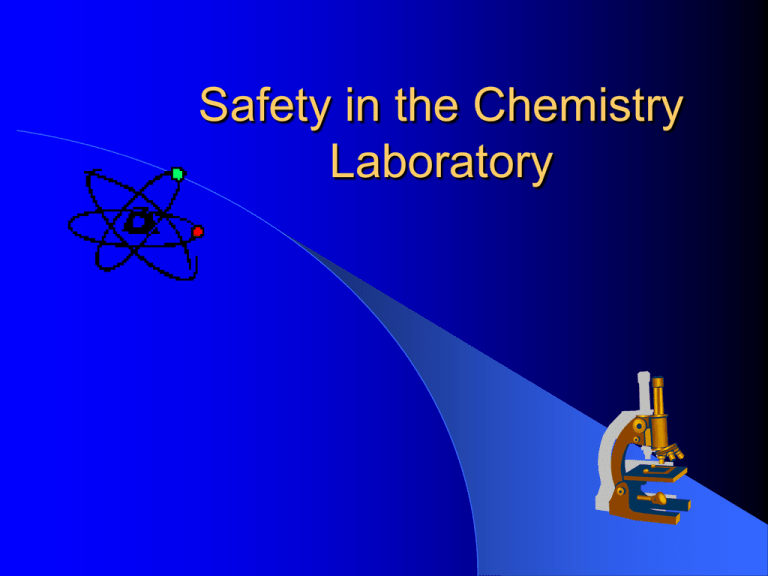
Safety in the Chemistry Laboratory What we have to learn to do, we learn by doing. -Aristotle Lab Expectations 1) Students must be involved in handson, laboratory activities for a minimum of 20% of the instructional time 2) Each student is required to participate in each lab. Why should safety be a central focus in our classroom? 1) Protects the student 2) Protects the teacher 3) Protects the school Instruction Think-Pair-Share (TPS) 1) Think about the video. Identify one safety precaution that was new to you or one you have violated in the past. 2) Share your idea with your partner. If it is a new precaution, explain why it is important. If it is one you have violated in the past, share your experience and outcome. 3) Share with the class Safety Rules Safety Rules, Cont. 1)Wear safety goggles at all times and a laboratory apron when necessary. – Goggles must be worn per State Law and because it is a safe practice – Students must wear full splash goggles – Must be disinfected between uses Safety Rules, Cont. 2) Conduct only assigned experiments and only when teachers is present. 3) Know the locations of all safety equipment such as the eyewash, fire extinguisher, emergency shower, and fire blanket. 4) Know when to use the safety equipment. Safety Rules, Cont. 5) Do not chew gum, eat or drink in the lab. Never taste chemicals. 6) Notify your teacher immediately of any spills. 7) Report all accidents no matter how slight to the teacher immediately. Safety Rules, Cont. 8) Pin or tie back long hair and roll up loose sleeves when working in the lab. 9) Do not leave a lit burner unattended. 10) To avoid contamination, do not return unused chemicals to a reagent bottle. Always discard or pass another group. Safety Rules, cont. 11) Do not used chipped or cracked glassware. Discard it in glass container. 12) When diluting an acid, always pour acid slowly into water, stirring constantly. 13) When heating a liquid in a test tube, turn the mouth of a test tube away from yourself and others. Safety Rules, cont. 14) Clean up spills and broken glass immediately. Leave your work area clean at the end of the lab period. 15) Wash your hands with soap and water before leaving the lab. Sketch 1) Draw a picture of the room and place all safety equipment in their proper locations. You may only draw or use symbols. No words. 2) Switch seats with your partner and have them label your drawing. 3) Check your accuracy Minor Accidents Safe Response Situation 1) Burns 2) Fainting 3) Eye Injury Immediately flush with cold water until the burning sensation subsides. Move to fresh air. Move the person so that the head is lower than the rest of the body Immediately flush the eye with running water for 10 minutes. Remove contact lenses. Do not rub if foreign object is present. Minor Accidents, cont. Situation 4) Minor Cuts 5) Poisoning 6) Spills on skin Safe Response Allow to bleed briefly. Wash with soap and water. Note what substance was responsible. Alert teacher immediately. Flush with water. Minor Accidents, cont. Situation 7) Fire Safe Response Turn off all gas outlets. Unplug appliances. Use fire blanket if someone's clothes are on fire. Set beaker or watch glass to cover and smother a small fire. Use fire extinguisher to smother larger fires. Proper Disposal 1) Make sure chemicals are disposed of properly. Ask if you are unsure. 2) No solids in the sink 3) Broken glass and sharp objects should be placed in broken glass container. Safety Contract 1) Safety Contract for All Students 2) Contact Lens Contract Ticket out the door List 3 things you learned that were new to you today.
